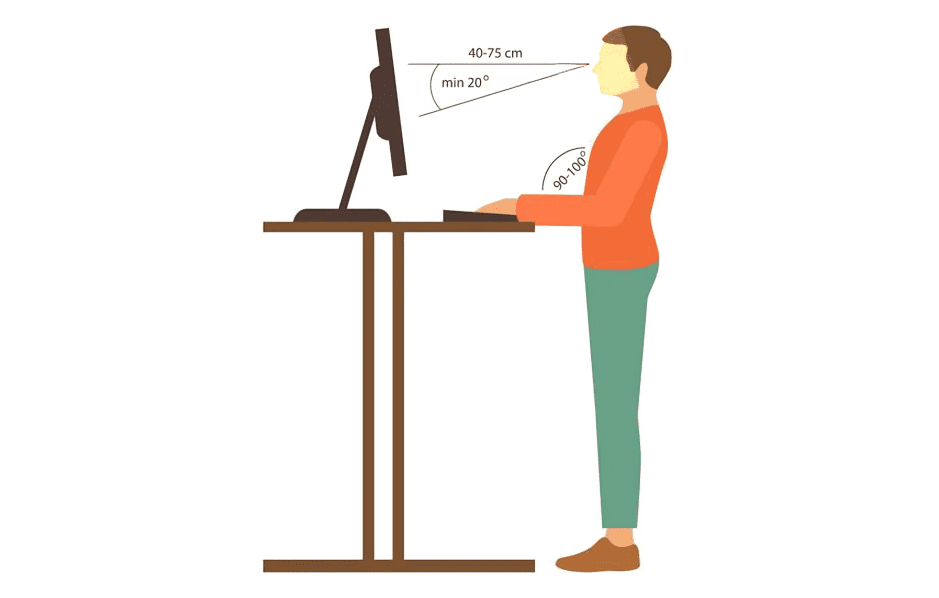This post contains affiliate links.
In today’s dynamic work environments, aligning ergonomic principles with our workspace setup is crucial. Standing desks, known for their health and productivity benefits, are central to this ergonomic shift. Finding their ideal height is vital for comfort and long-term health.
The perfect height for a standing desk is where your arms rest at a 90-degree angle while typing. This position ensures an upright posture, reducing strain on your back, neck, and shoulders.
This guide provides detailed insights and practical steps to adjust your standing desk height perfectly. It helps create a workspace that boosts productivity and supports your health and comfort.
How High Should Standing Desk Be?
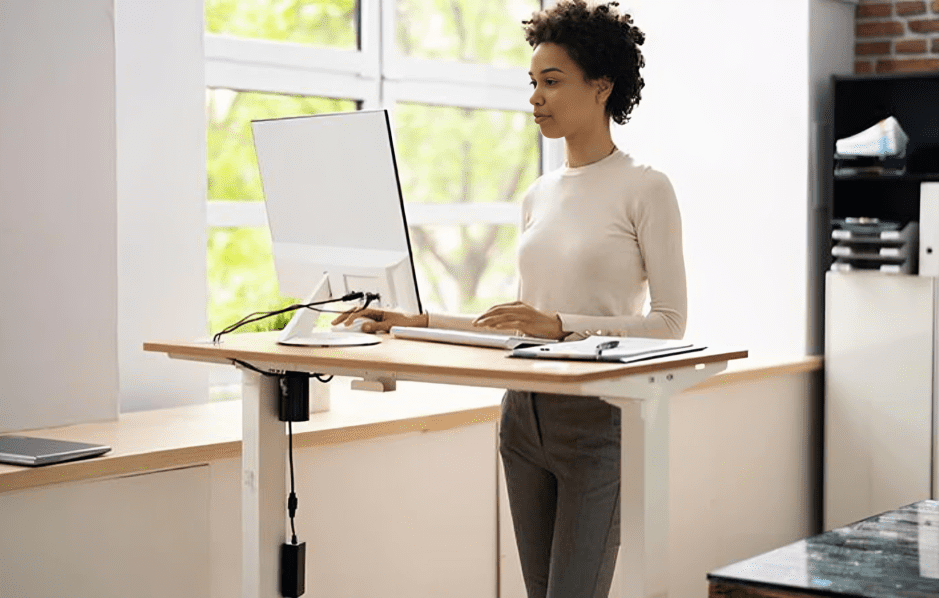
The ideal height of a standing desk is crucial for maintaining a comfortable and ergonomic posture while standing. It should be set so that the user’s elbows are at a 90-degree angle when their arms rest on the desk surface. This position ensures that the shoulders remain relaxed and not hunched.
The wrists should be straight while typing or using a mouse, contributing to a healthy ergonomic posture. For most individuals, this height aligns with their elbow level. However, it’s important to recognize that due to variations in body proportions, the ideal desk height can differ from person to person.
Adjustable standing desks are highly beneficial as they allow users to alternate between sitting and standing positions. This adjustability also enables users to fine-tune the desk height to their specific needs. Accompanying accessories like an adjustable chair or a standing desk mat like this can further enhance ergonomic benefits.
Regular adjustments to the desk height are recommended to ensure maximum comfort. Users should also be mindful of their posture, conducting regular checks to maintain an optimal ergonomic setup. This practice helps in maximizing the benefits of a standing desk while minimizing potential discomfort.
What is Ideal Height of Standing Desk For Your Height?
The ideal height of a standing desk relative to your height is a key factor in ensuring ergonomic comfort and effectiveness. To determine this ideal height, a simple yet effective approach is to use your own body measurements as a guide.
The table below can help you calculate which standing desk height is right for you based on how tall you are.
| Your Height | Sitting Desk Height | Standing Desk Height |
|---|---|---|
| 5’0″ | 22.5″ | 36.5″ |
| 5’1″ | 23″ | 37″ |
| 5’2″ | 23″ | 37.5″ |
| 5’3″ | 23.5″ | 38″ |
| 5’4″ | 24″ | 39″ |
| 5’5″ | 24.5″ | 39.5 |
| 5’6″ | 25″ | 40.5″ |
| 5’7″ | 25″ | 41″ |
| 5’8″ | 25.5″ | 41.5″ |
| 5’9″ | 26″ | 42.5″ |
| 5’10” | 26.5″ | 43″ |
| 5’11” | 27″ | 43.5″ |
| 6’0″ | 27″ | 44″ |
| 6’1″ | 27.5″ | 44.5″ |
| 6’2″ | 28″ | 44.5″ |
| 6’3″ | 28.5″ | 46″ |
| 6’4″ | 28.5″ | 47″ |
| 6’5″ | 29″ | 47.5″ |
| 6’6″ | 29″ | 48″ |
| 6’7″ | 29.5″ | 49″ |
| 6’8″ | 30″ | 49.5″ |
Step-by-Step Guide to Finding Your Perfect Height
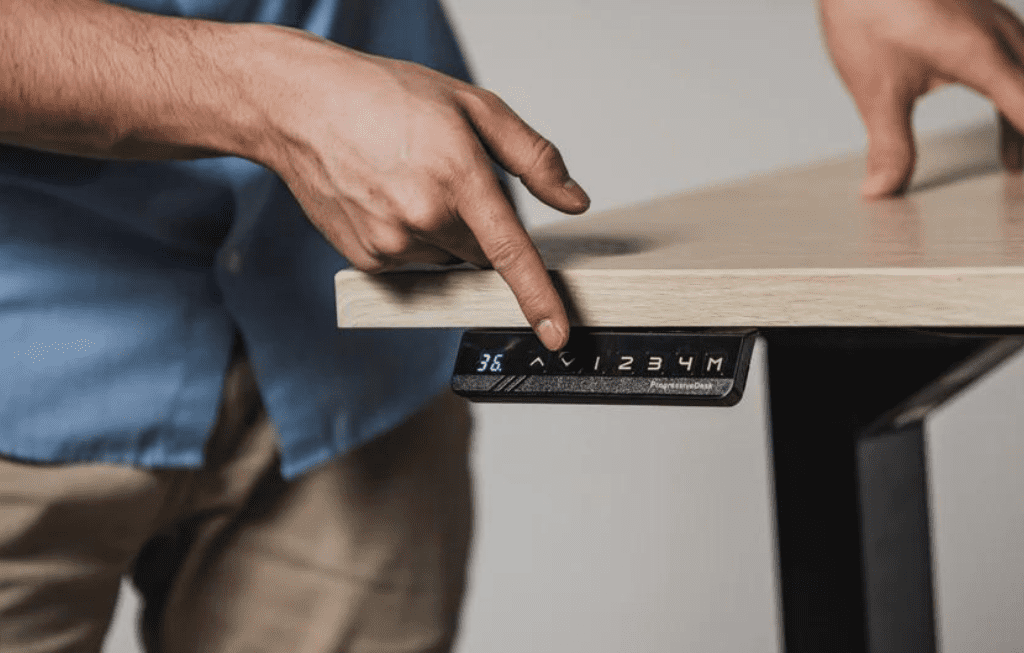
The following steps help you to establish a standing desk height that promotes comfort and ergonomic alignment, ideal for your height.
1. Measure Your Full Height
Start by measuring your height from the top of your head to your feet. This measurement is crucial as it forms the basis for adjusting your desk height.
2. Calculate Elbow Height
Stand up straight and bend your elbows at a 90-degree angle, similar to the position you would have while typing. Measure the distance from the floor to the bottom of your elbow. This measurement is your target desk height for standing. It ensures that your arms can rest comfortably on the desk without straining your shoulders.
3. Adjust Monitor Height
Eye level alignment is key to avoiding neck strain. Position your monitor so that when you look straight ahead, your gaze naturally falls on the top third of the screen. This alignment helps in maintaining a straight neck posture, reducing the risk of neck pain associated with looking down or up for extended periods.
4. Fine-Tune the Setup
With your desk adjusted to the height based on your elbow measurement, start using it. Pay attention to how your body feels. Are your shoulders relaxed? Are your wrists comfortable while typing? Make small adjustments to the desk height over several days. This fine-tuning process is important as it helps in identifying the most comfortable and sustainable position for long-term use.
Adjusting Standing Desk Height from a Sitting Position
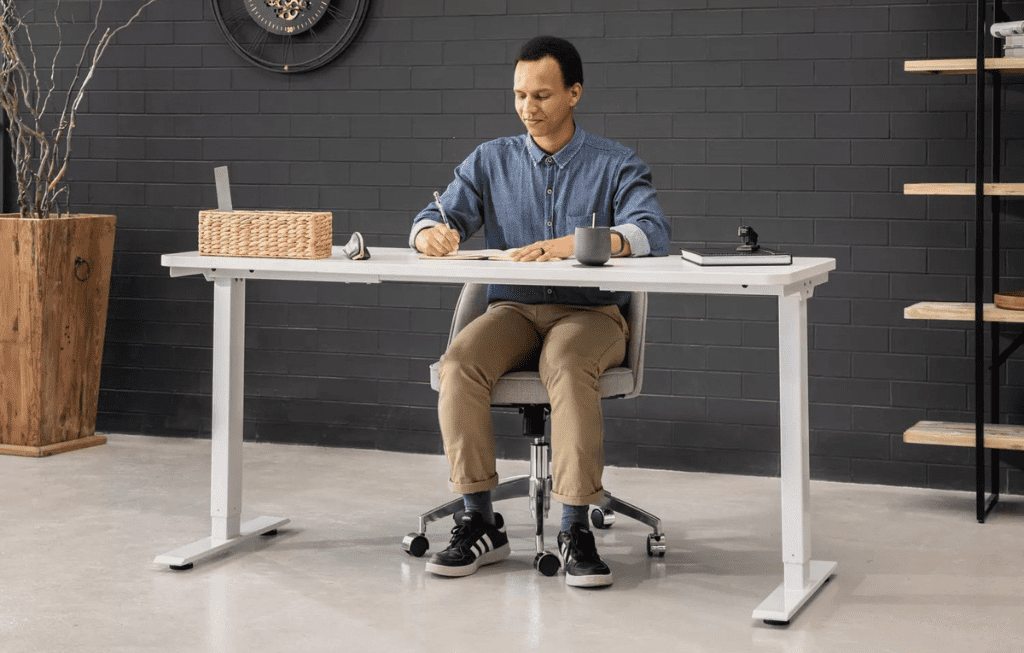
Properly adjusting the height of your standing desk is crucial, not just for standing but also for sitting comfortably. This is essential for those who alternate between sitting and standing at their desk. Here’s how to do it:
1. Measure Elbow Height While Seated
Begin by sitting comfortably in your chair, ensuring your feet are flat on the floor. This seated position serves as your reference point. Bend your elbows at a 90-degree angle, as if you were typing on a keyboard. Then, measure the distance from the floor to the bottom of your elbows.
2. Set Desk to Match Elbow Height
Once you have the elbow-to-floor measurement, adjust the height of your standing desk. Align the desk surface with the height you just measured. This alignment ensures that when you sit and place your arms on the desk, your elbows can rest comfortably without being too high or too low. It promotes a natural posture while typing or working.
3. Align Monitor for Eye Level
Position your monitor so that its top edge is at or just slightly below your eye level when you are seated. This monitor alignment is essential for reducing neck strain and maintaining a straight neck posture while working in a seated position.
4. Test and Adjust
Work in this position and make minor adjustments for comfort. Ensure your wrists are straight and shoulders relaxed.
Essential Accessories for Fine-Tuning Standing Desk Setup
To enhance and fine-tune your standing desk setup for optimal comfort and efficiency during long working hours, certain accessories are considered essential. Here’s a list of key accessories:
1. Adjustable Monitor Stand
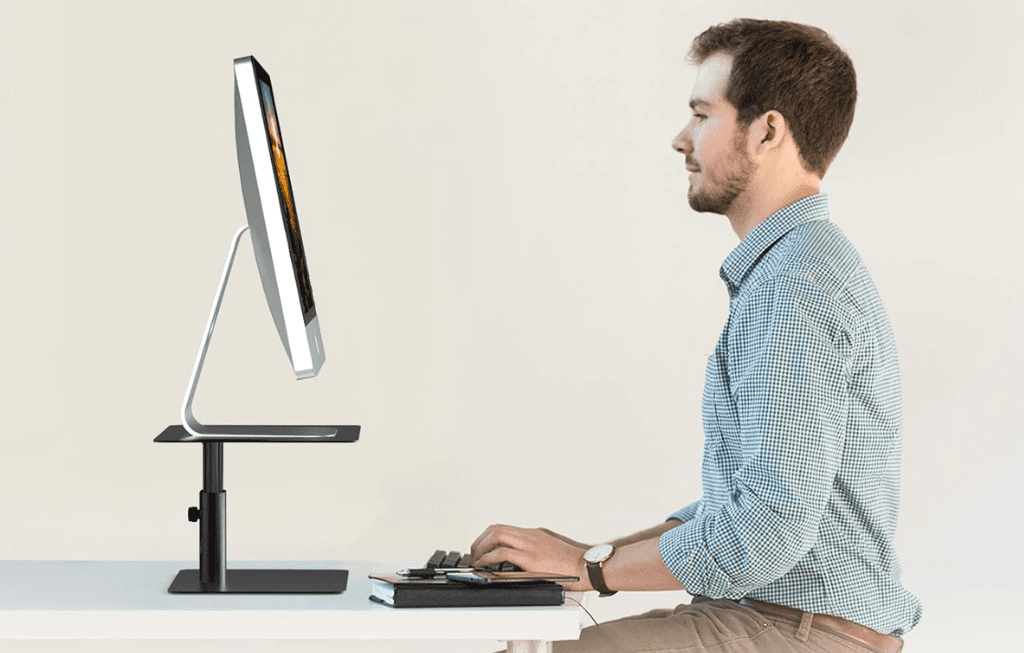
Adjustable monitor stand allows you to position your monitor at the ideal eye level, which helps in reducing neck strain and maintaining proper posture. If your monitor comes with a built-in stand, this adjustable monitor stand is perfect for you. If your monitor doesn’t have a stand, you’ll definitely need an adjustable stand with VESA compatibility like this one to mount it securely.
2. Ergonomic Keyboard Tray
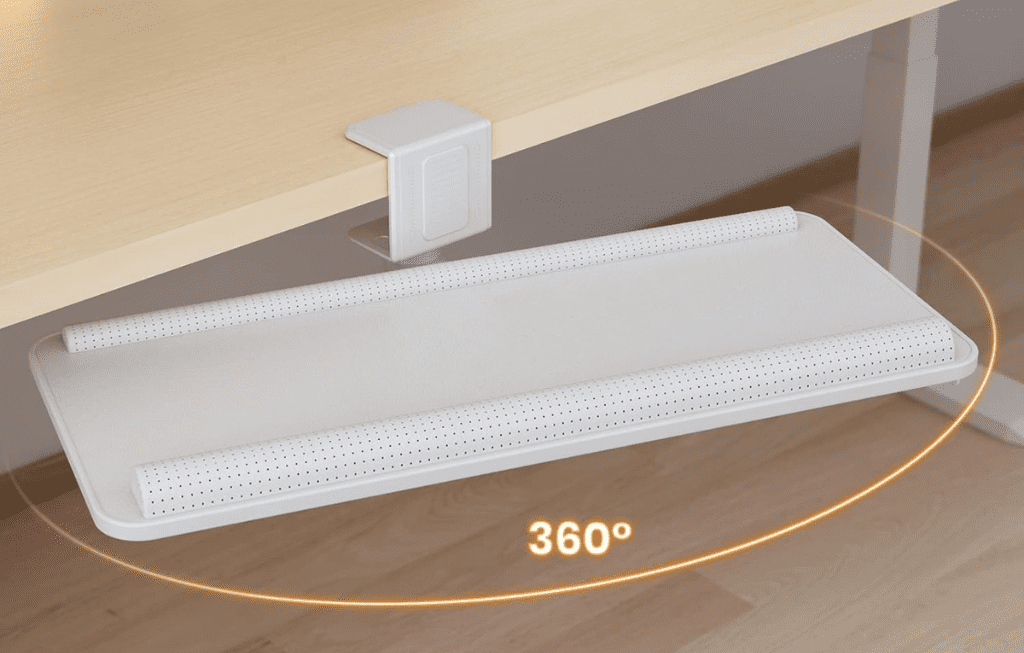
An ergonomic keyboard tray enables adjustable positioning of your keyboard and mouse, promoting wrist health and preventing strain. This handy tray attaches securely to your desk with sturdy C-clamps, leaving your desk damage-free without you having to drill on your desk.
3. Anti-Fatigue Mat
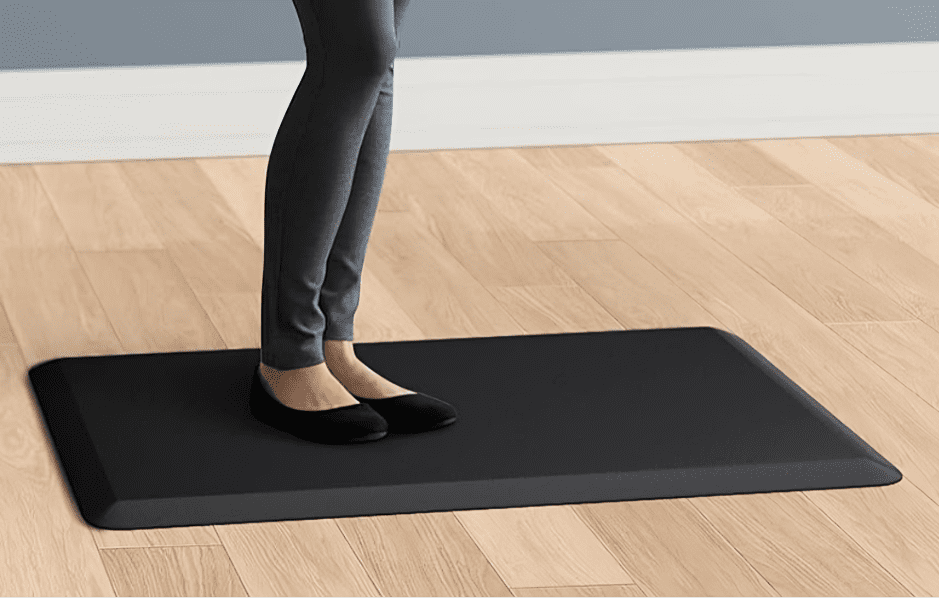
Standing for long periods can be taxing on your feet and legs. An anti-fatigue mat is designed to reduce discomfort and fatigue, making standing more comfortable.
4. Desk Chair with Adjustable Height
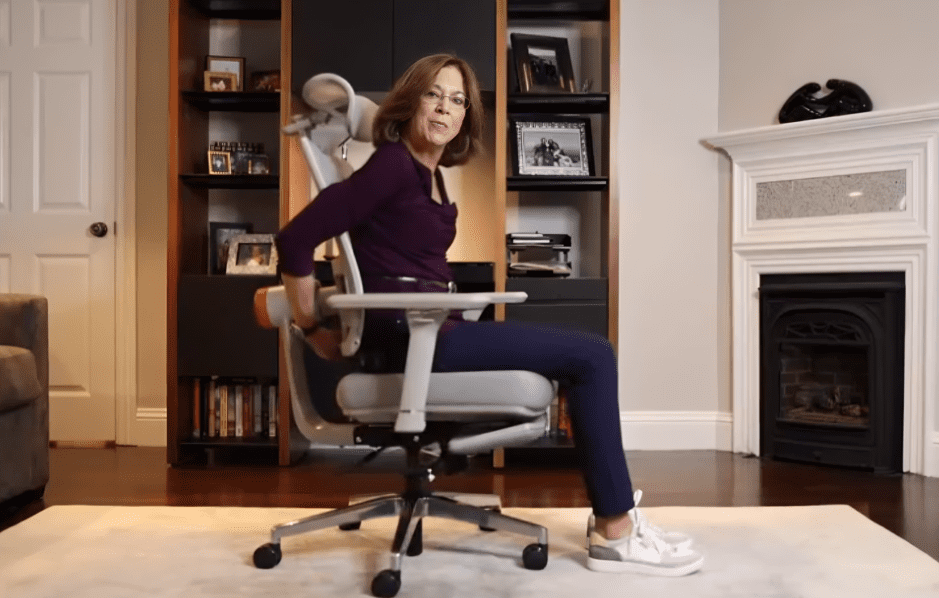
Essential for alternating between sitting and standing, a desk chair with adjustable height helps in maintaining proper posture during seated periods. This particular chair I found on Amazon offers all the necessary features for ergonomic comfort, including adjustable height, armrests, headrest, lumbar support, and backward tilt adjustment.
5. Cable Management Solutions
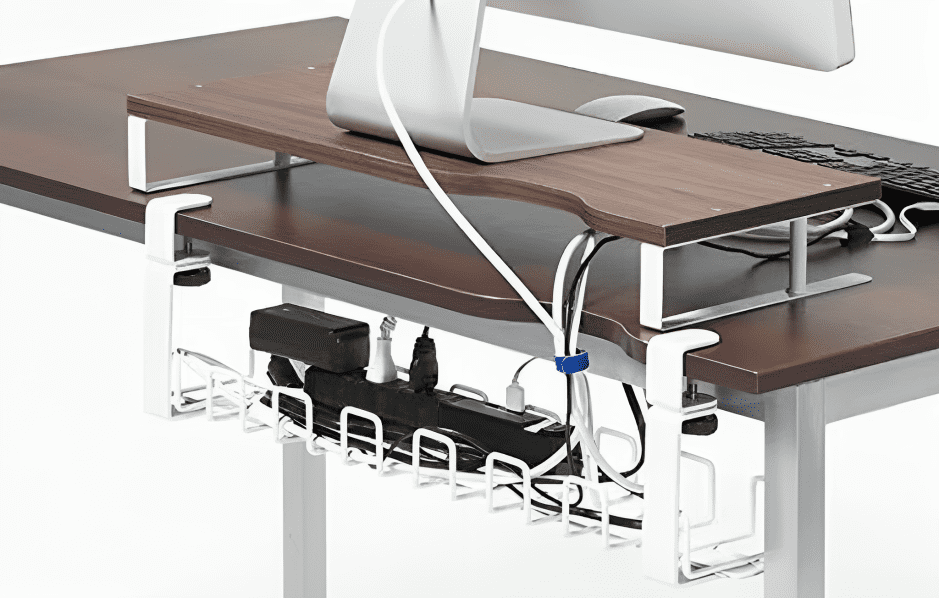
Organizing cables with solutions like cable trays or clips can reduce clutter and potential tripping hazards, keeping your workspace safe and tidy.
6. Desk Organizer
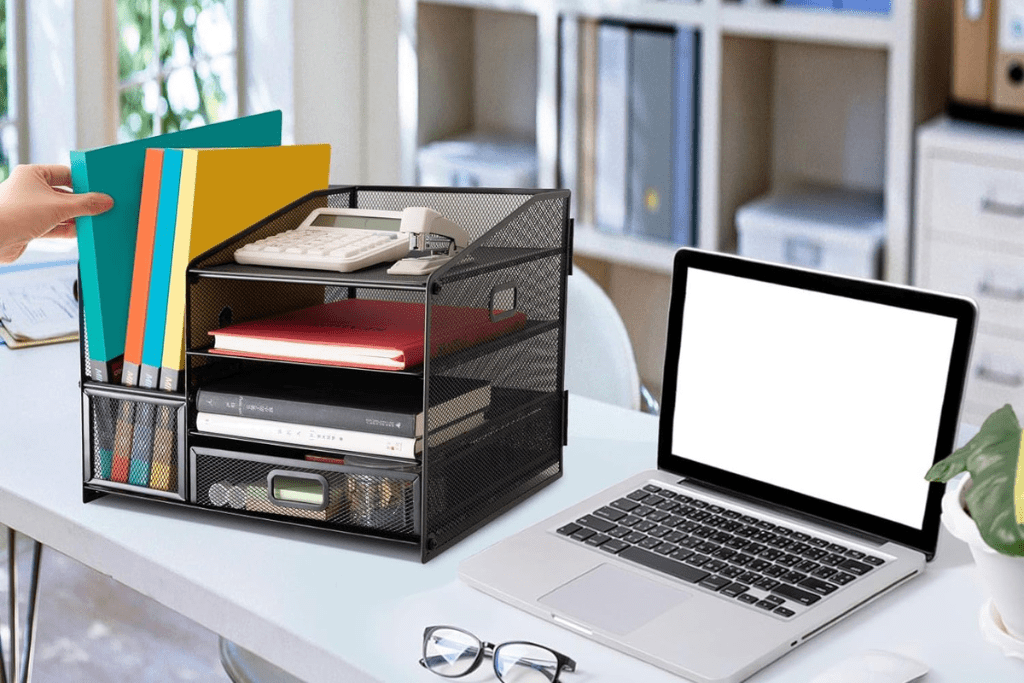
A desk organizer helps in keeping essential items within easy reach, ensuring your workspace remains orderly and efficient.
7. Under-Desk Bike or Treadmill
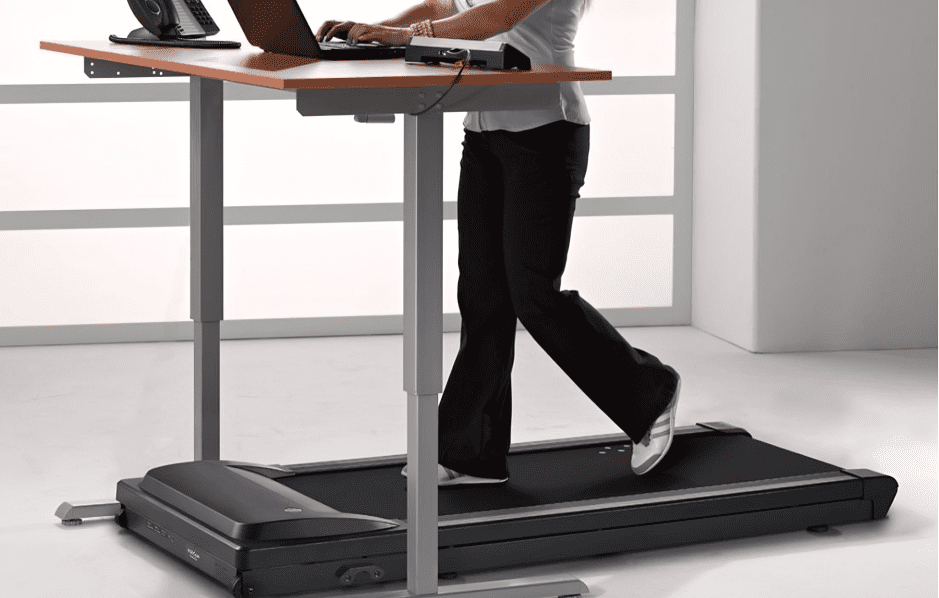
For those looking to stay active, an under-desk bike or treadmill encourages movement and can enhance physical fitness without leaving the desk.
8. Task Lighting
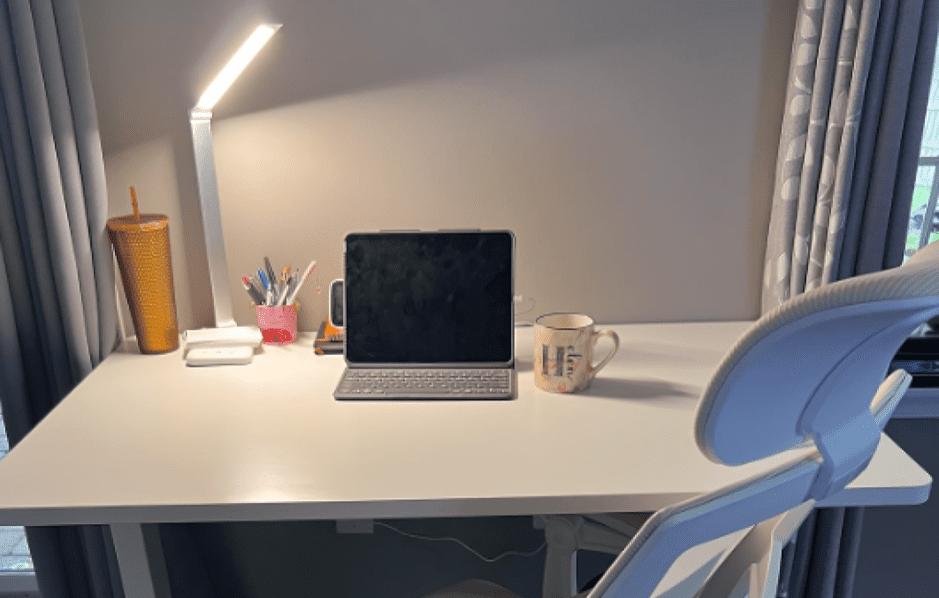
Adjustable task lighting like this one is crucial in setups with limited natural light. It reduces eye strain and improves focus, making your work environment more comfortable.
How Long Should You Stand at Standing Desk?

Finding the right amount of time to stand at a standing desk is about balancing the good parts of standing with the discomfort that can come from standing too long.
The main idea is to switch between sitting and standing throughout the day, rather than just standing all the time, for the best comfort and health benefits.
Research suggests that initially starting with a ratio of 1:1 for standing to sitting is beneficial. This means, for every hour of sitting, you should stand for an hour.
As per the “British Journal of Sports Medicine,” it’s recommended to aim for standing 2-4 hours during the workday, gradually increasing this as comfort allows.
Continuous standing can lead to physical fatigue, affecting concentration and productivity. It can also put strain on the lower back and legs. Alternating between sitting and standing helps to reduce the risks of sedentary behavior, such as cardiovascular disease and diabetes, as noted by several health studies.
Everyone is different when it comes to how long they like to stand or sit. Some people might prefer to stand for 30 minutes and then sit for 30 minutes. Also, the kind of work you’re doing matters. If you need to do detailed work with your hands, sitting down might be better.
How Much Height Is Too Low and Too High for Standing Desk

Calculating the ideal standing desk height begins with an accurate measurement of your height while wearing your everyday shoes. This step is crucial as it ensures that the desk height aligns with your actual working stature. Here’s how to do it:
- Wear the shoes you typically use at your desk.
- Stand straight against a wall, keeping your heels and head level.
- Use a tape measure to determine the distance from the ground to the top of your head.
This measurement is vital as it forms the basis for calculating the correct height of your standing desk.
After measuring your height with shoes, the next steps are:
Minimum Desk Height: Subtract 8.5 inches from your total height. This number represents the lowest ergonomic point of your standing desk.
Maximum Desk Height: Subtract 6 inches from your height. This figure indicates the highest comfortable position for your standing desk.
These calculations ensure that your standing desk falls within a range that is both ergonomically sound and comfortable, minimizing the risk of posture-related strain.
Common Mistakes When Determining a Standing Desk Height
When setting up a standing desk, common errors can affect comfort and ergonomics:
- Relying Solely on Height Charts: While helpful, these charts shouldn’t be your only guide. Personal body size and shoe height play significant roles in determining the right desk height.
- Ignoring Accessories: Keyboard trays, anti-fatigue mats, and monitor stands can alter the needed desk height. Include these in your calculations for accuracy.
- Neglecting Sitting Posture: Your standing desk should accommodate both standing and sitting postures. Adjust accordingly for both scenarios.
- Over-Elevating the Desk: A desk set too high can be as problematic as one too low, leading to discomfort and poor posture.
To avoid these pitfalls, take your time to measure, adjust, and retest your setup, paying attention to how your body responds to these changes.
Before You Go…
Taking the time to adjust your desk can really help your health and how well you work. Remember, finding the right desk height is personal, and it’s okay to test out what feels best for you.
If you’re thinking about switching from sitting to standing while you work and want to make your regular desk higher, I encourage you to check out my previous article. This article also provides useful tips and reasons why making your desk higher can be beneficial for you.

